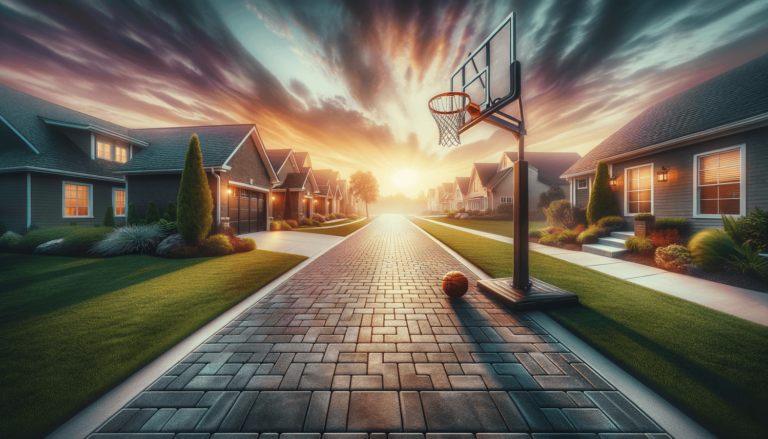
Finding the perfect spot for your basketball hoop in the driveway can transform your home into an exciting, fun-filled court for friends and family to enjoy! But the question remains: where do you position your hoop to maximize space and safety while still looking stylish? In this blog post, we’ll dunk into the essentials of hoop placement, breaking down key factors such as regulations, recommended dimensions, and even terrain considerations. So, lace up your sneakers and get ready for a swish of information that will have you shooting hoops in no time!
Where to Put Basketball Hoop in Driveway?
Place your basketball hoop in the driveway at a location with ample playing space, a flat surface, and clear sightlines. Ideally, position the backboard and pole about 2-3 feet from the edge of the driveway, ensuring it doesn’t obstruct pathways or driveways. The hoop should also account for an NCAA-regulated free-throw line at 15 feet away and a standard three-point line at 19.75 feet for optimal gameplay. Make sure to check local building and safety regulations prior to installation for a seamless experience.
Size Up Your Space
Before deciding where to put your basketball hoop, it’s important to assess the available space and ensure there’s enough room for a great game. A half-court setup is ideal for a typical driveway and requires a minimum area of 30 feet in length by 25 feet in width. This allows for essential markings like 3-point lines and free throw lanes while leaving enough room for some footwork action. Make sure your driveway isn’t cluttered with cars, gardening tools, or any other potential tripping hazards that can interrupt your fast breaks and passes.
Safety First: Choosing the Right Location
When it comes to installing your hoop, safety should be a top priority. Here are a few crucial factors to consider while selecting the perfect spot for your new basketball arena:
Flat Surfaces and Inclines
Ensure that the basketball court is on a flat and level surface to minimize the risk of erratic bounces, tripping, and injury-causing incidents. If your driveway has a slight incline, consider leveling the ground before installation or choose a hoop with an adjustable height system to compensate for the unevenness.
Off the Beaten Path
Position your hoop away from areas with high pedestrian and vehicular traffic, like a public walkway or where cars are parked. This prevents common accidents such as wayward basketballs hitting windows and bystanders while ensuring that players can enjoy the game without interference.
Buffer Zone
Maintain a two to three feet distance between the pole and the edge of your driveway, creating a safe buffer zone that protects both property lines and your neighbors’ yards. This also prevents arguments and misunderstandings among neighbors, leaving everyone in the neighborhood feeling like a team player.
Legal Hoops: Local Regulations and Permits
Before breaking ground on your new hoop placement, it’s crucial to review local building and safety regulations that may impact your installation. Research permits, zoning laws, and homeowner association rules, which can vary by state, city, or even community. By staying informed and navigating legal requirements, you can avoid potential fines, violations, or even forced hoop removal – enabling your basketball fun to roll on uninterrupted.
Add the Lines: Marking Your Driveway Basketball Court
Once you have chosen the ideal location for your hoop, adding NCAA-regulated lines to your court amplifies the authenticity and functionality of your driveway basketball court. Establishing a boundary line, free-throw line, and three-point line adds structure and depth to the gameplay, all while boosting your skills in the process! Here’s a breakdown of these essential court markings:
Boundaries
Creating a boundary line along the edges of your driveway prevents players from venturing off the court during the game, minimizing the chance of injuries from obstacles or uneven terrain. This also helps to clearly demarcate the playing area and maintain the neighbors’ privacy as well.
Free Throw Line
Measure 15 feet away from the backboard and mark the free-throw line horizontally across your driveway. This line serves as the designated spot for taking free throws after fouls or violations, providing a fair opportunity to score points and maintain the pacing of the game.
Three-Point Line
With its semi-circular shape, the three-point line brings an air of excitement to the game while allowing players to showcase their long-range shooting skills. In a half-court setting, measure 19.75 feet away from the center of the backboard and draw a semi-circle that intersects the boundaries of the court. This line signifies the minimum distance players must be from the hoop to score a thrilling three-point shot.
On the Level: Measuring Hoop Height
For a truly authentic and versatile playing experience, set your hoop height according to official regulations. For a full regulation experience aim for a hoop height of 10 feet, which matches the standard across high school, college, and professional basketball games. Having a hoop that adheres to regulation standards enhances the gameplay and allows players to develop their skills on a standardized court, making the transition to official games all the more seamless.
Adjustable Hoops for All Ages
If your playing audience is on the younger side or features multiple age groups, consider investing in an adjustable height basketball hoop. This allows the game to be more inclusive, leveling the playing field for younger or less physically developed players. Adjustable hoops can be easily modified to accommodate various heights and skill levels, ensuring nobody feels left out of the fun.
Choose Your Hoop Wisely: In-Ground vs. Portable Systems
With a clear understanding of your space and desired court markings, it’s time to consider which hoop system best suits your needs: in-ground or portable. Both systems have their own set of advantages, enhancing your driveway basketball court in their own unique way. Here’s a breakdown of the two systems to help you make the most informed decision:
In-Ground Basketball Hoop Systems
In-ground basketball hoops are installed permanently into the ground, providing unmatched stability and durability. These systems are best for those looking for a long-term installation and a more professional feel to their court. Additionally, they tend to have a more consistent bounce due to their sturdiness, making for a more engaging gameplay experience. However, they do require more effort and expertise for proper installation and may not be easily relocated should the need arise.
Portable Basketball Hoop Systems
Portable basketball hoops are designed to be flexible and easily relocated, offering a more adaptable court setup for those with changing needs or space constraints. These systems use a weighted base filled with sand or water to maintain stability and can be easily moved around as needed. Though they provide greater flexibility, portable hoops may experience more wobble compared to their in-ground counterparts, which can impact gameplay. Make sure to choose a model with a quality-built base and sturdy pole to minimize these concerns.
Maintaining Your Driveway Court
Once you’ve set up your dream driveway basketball court, it’s crucial to ensure it stays in tip-top shape for years to come. Proper maintenance is not only about appearance but also safeguards against potential injuries and prolongs the life of your hoop system. Here are some key maintenance tips to keep your court looking and playing its best:
Check for Wear and Tear
Regularly examine your basketball hoop, pole, and net for signs of wear or damage. Address noticeable issues promptly, including any rust, bent rims, or frayed netting. Timely repairs and replacements prevent minor issues from escalating, ensuring your court remains a safe and enjoyable environment for all.
Keep it Clean
Sweep or blow away dirt, leaves, and debris from your driveway court regularly, as these can create slippery surfaces or obstruct your gameplay. Periodically power-washing the surface can also help remove stubborn dirt, stains, or accumulated grime that traditional sweeping may not address.
Annual Paint Touch-Up
Re-apply paint or repaint your court’s lines and boundaries as needed to keep the playing area looking fresh and clearly defined. This annual touch-up not only maintains the aesthetic appeal of your court but also helps players follow the rules accurately, leading to a smoother gameplay experience.
With the expert knowledge you’ve gained, you’re ready to build the ultimate driveway basketball court for your home, creating an inviting space to play, practice, and perfect your skills. From selecting the right spot to exploring in-ground or portable hoop systems, these guidelines ensure that you’re well on your way to enjoying hours of fun-filled and exhilarating driveway basketball action!
Consider Your Neighbors
While your driveway’s configuration and space are crucial in deciding where to place a basketball hoop, it is also essential to consider your neighbors’ perspective. Playing on your driveway court can generate noise, which may not sit well with everyone in the neighborhood. Make sure to check with your neighbors before installation, maintaining open communication lines to find a solution that works for everyone. Remember that a little courtesy can go a long way in fostering great neighborhood relations.
Light It Up: Installing Court Lighting
One surefire way to extend the hours of enjoyment on your driveway basketball court is to add proper lighting. Having a well-illuminated space not only increases visibility for nighttime games but also enhances safety for players. Look into energy-efficient LED lighting systems, which provide ample illumination and have minimal impact on your electricity bill. When installing lights, consider your neighbors again; you don’t want to shine a spotlight on their homes. Angle the lights towards the court and away from surrounding properties to minimize lighting disturbances.
Accessorize Your Court
A few simple yet effective accessories can greatly improve your basketball experience on the driveway. Here are some popular options to consider:
Ball Return System
A ball return system channels made baskets back to players, saving time, and energy on retrieving stray basketballs. This keeps the game moving and reduces the chance of basketballs rolling into neighboring yards or busy streets. There are various attachments and systems available, so seek the one best suited for your hoop and driveway setup.
Rebounding System
To maximize your shots and rebounds practice, a rebounding system can be a valuable addition to your court. Designed to assist in gathering missed shots, these systems help return the ball to the shooter, providing more opportunities for continuous shooting and improving skills.
Driveway Court Line Kits
Transform your driveway into a realistically marked basketball court with driveway court line kits. These kits offer stencils, tapes, or other easy-to-use tools to create lines and markings that follow NCAA regulations. With the proper dimensions and markings in place, your driveway court becomes an even better training ground for aspiring basketball enthusiasts.
Focus on Skills and Engagement
Remember that the primary goal of installing a basketball hoop in your driveway is to enjoy the game, hone your skills, and have fun with friends and family. No matter where you place the hoop or what accessories you add, focus on the opportunity for engagement, community building, and active recreation that comes with having a basketball court right outside your home. Get the whole neighborhood involved, and you might notice an increase in camaraderie, laughter, and healthy competition all tied closely to your driveway’s basketball hoop.
Frequently Asked Questions
Whether you’re new to the game of driveway basketball or a seasoned pro, an array of questions may arise as you work on setting up the perfect court. To help you make informed decisions, we’ve compiled a list of FAQs that dive deeper into some key aspects of installing a basketball hoop in your driveway.
1. What are the regulation measurements for basketball court lines in my driveway?
For a half-court driveway setup, use these NCAA-regulated measurements: Free-throw line at 15 feet away from the backboard, and three-point line in a semi-circular shape at 19.75 feet away from the backboard’s center.
2. Can I adjust the height of an in-ground basketball hoop?
Yes, many in-ground basketball hoop models feature adjustable height systems. Before purchasing, check the product specifications to ensure the model can be adjusted according to your needs.
3. Does my driveway need to be a certain width for a basketball hoop installation?
An ideal half-court setup for a driveway should be at least 30 feet in length and 25 feet in width. However, if your driveway does not meet these guidelines, work with your available space and adjust accordingly.
4. Can I still play basketball on an incline or uneven driveway?
It’s possible, but playing on an incline or uneven driveway can be challenging and increase the risk of injuries. If necessary, consider leveling the driveway or choosing a hoop system with an adjustable height mechanism to compensate for the unevenness.
5. How do I ensure my portable basketball hoop remains stable?
Choose a portable hoop with a sturdy base and high-quality pole. Fill the base with sand or water according to the manufacturer’s instructions, and periodically check its stability, adjusting and refilling as needed.
6. How far should my hoop be from my neighbor’s property line?
Maintain a buffer zone of at least 2-3 feet between the pole and your neighbor’s property line. Always consider your neighbors’ preferences and local regulations, adjusting the distance accordingly.
7. How can I prevent damage to my property while playing basketball in my driveway?
Choose a safe location for your hoop with ample space and distance from windows, cars, and other valuables. Maintain frequent communication with players about appropriate behavior and safety measures to minimize potential damage.
8. How deep do I need to install the pole for an in-ground basketball hoop?
Installation depth requirements vary by hoop system, so consult the manufacturer’s guidelines for specific details. Generally, poles should be installed approximately 4 feet deep and secured with a concrete base for optimal stability.
9. Can I install a basketball hoop on the side or back of my garage?
Yes, you can install a hoop on either the side or back of a garage, provided there’s sufficient space to accommodate the game. Ensure that the hoop does not obstruct pathways or driveway access, and carefully consider the height and angle to minimize potential damage to the garage.
10. How often should I replace the net on my basketball hoop?
Replace your net when it shows signs of wear, such as tearing, fraying or losing its shape. Regularly inspect your net and address any fluctuations or wear promptly to ensure optimal gameplay and safety.
11. Can I install a tempered glass backboard in my driveway?
Yes, you can install a tempered glass backboard in your driveway. Though often more expensive and heavier than other materials, these backboards closely resemble those used in professional basketball settings, providing an authentic play experience.
12. In which direction should the basketball hoop face in the driveway?
While there is no set direction for your basketball hoop, consider factors such as sunlight, wind direction, and neighbors’ preferences when deciding on orientation. The ideal hoop direction offers maximum playability, considering external factors that may affect gameplay.
13. How do I level a portable basketball hoop base that wobbles?
Check your hoop’s base for cracks or leaks, and ensure it’s filled with sand or water as per the manufacturer’s recommendations to provide maximum stability. Level the playing surface beneath the base, using plywood, rubber mats, or other stable materials to balance any unevenness.
Featured Posts
- No pillar pages found.





